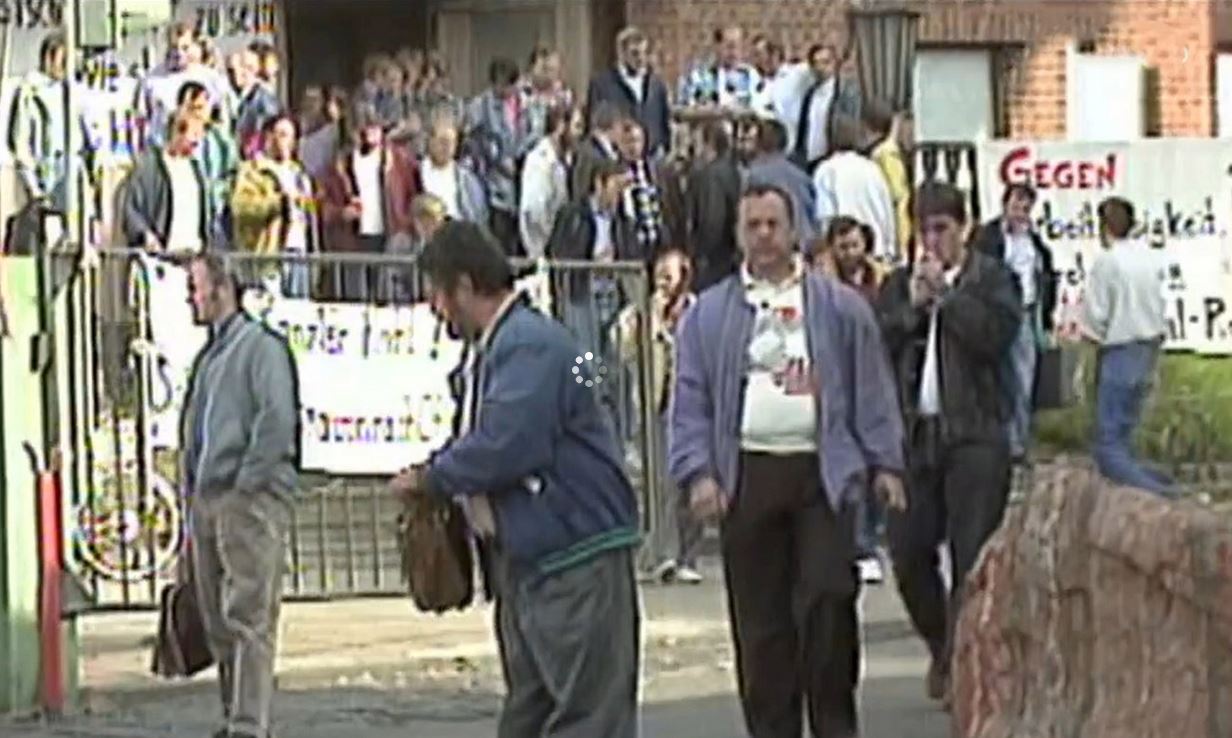The Bischofferode protests, 1993

In 1993 the Bischofferode Kali salt mines were the site of one of the few nationally and internationally noted of the hundreds of annual occupations and strikes in the years after the East German revolution and the so-called reunification. As early as January 1990, the miners in the Thuringian mines, carried on the all-pervasive wave of self-emancipation, had led an early and successful strike to demand higher wages and greater autonomy from the transitional Socialist government. Later that year, the traditionally conservative, mostly Catholic population of the region had embraced the German unification enthusiastically, setting about adapting their company to the new economic system – with astonishing success. They secured the company’s international customer base and kept the mines competitive. Nevertheless the Treuhand Agency sells the mines off to West German salt conglomerate (Kali und Salz AG, owned by chemical giant BASF). Despite, or more likely because of, the company’s exceptional economic viability, the new owners soon announce their intention to close the eastern competitor down.
For the miners this sets in motion a whole new and unforeseen learning process of how to be in this new system and how to assert their new-found democratic skills and determination in and against this new state. They will teach themselves how to conduct an occupation and a hunger strike lasting 81 days. They will learn how to organise nation-wide attention and support, how to hold rallies and talk to media representatives. They will learn and experience in their own bodies how this Western democracy writes the neoliberal mantra that there is no alternative into factuality with the full array of its executive and judicial force: The police sends agents provocateurs to brand their protests as violent, the courts prosecute in due course. The media contribute their part to give credence to the image of the miners as violent thugs. On Christmas Eve 1993, a year of strikes and protest ends, when the new owners inform the miners that their demands to keep the mine going will not be met. A four-year process of self-emancipation in and against two social and political systems comes to an end.
The protests at Bischofferode and elsewhere and two subsequent waves of East German mass protests[1] would later be filed away as irrelevant, and as unconnected to the 1989 revolution, under the “Jammerossi” trope, a caricature, albeit a powerful one, that casts east Germans as perennially politically apathetic and democratically inept,[2]: It depoliticised a set of highly political affects, it denounced and diffused their political force. It erased the revolutionaries’ achievement and recast them as ungrateful children, who got what they wanted and still complained.[3]
[1] The first wave of protests began as early as March 1991, and saw 150 – 200 annual workers protests until 1994; a second wave of protests brought tens of thousands (45.000 at their height in Leipzig) back to the streets against the Iraq War in 2003 and then again against the dismantling of the “Harz IV” social reforms in 2004. All of these protests drew on the 1989/90 protests in their iconography, formats, slogan, including their name “Monday demonstrations” and the call “Wir sind das Volk.” (See: www.mythos-montagsdemonstrationen.de/)
[2] Political engagement tends to be measured in (Western) terms of membership in parties and labour organisations, see for example: Josa Mania-Schlegel, ‘Nach der Europawahl: Fremd im eigenen Land’, Krautreporter, accessed 29 May 2019, https://krautreporter.de/2912-nach-der-europawahl-fremd-im-eigenen-land, with little understanding or sensitivity to the east German context – where parties and unions were largely discredited after 1990 and engagement tended to take different forms. Lack of engagement is then attributed to alleged antidemocratic traditions in the East, see for example, Magnus Brechtken, ‘Das Selbstbild der Unberührten’, F.A.Z. Plus, accessed 8 March 2021, https://zeitung.faz.net/feuilleton/2017-12-18/f94b0e4adc03220995dc68152fb01ca5?GEPC=s2.
[3] Boris Buden describes this process of infantilisation in: Zone des Übergangs: vom Ende des Postkommunismus (Frankfurt, M.: Suhrkamp, 2009), 32–33.